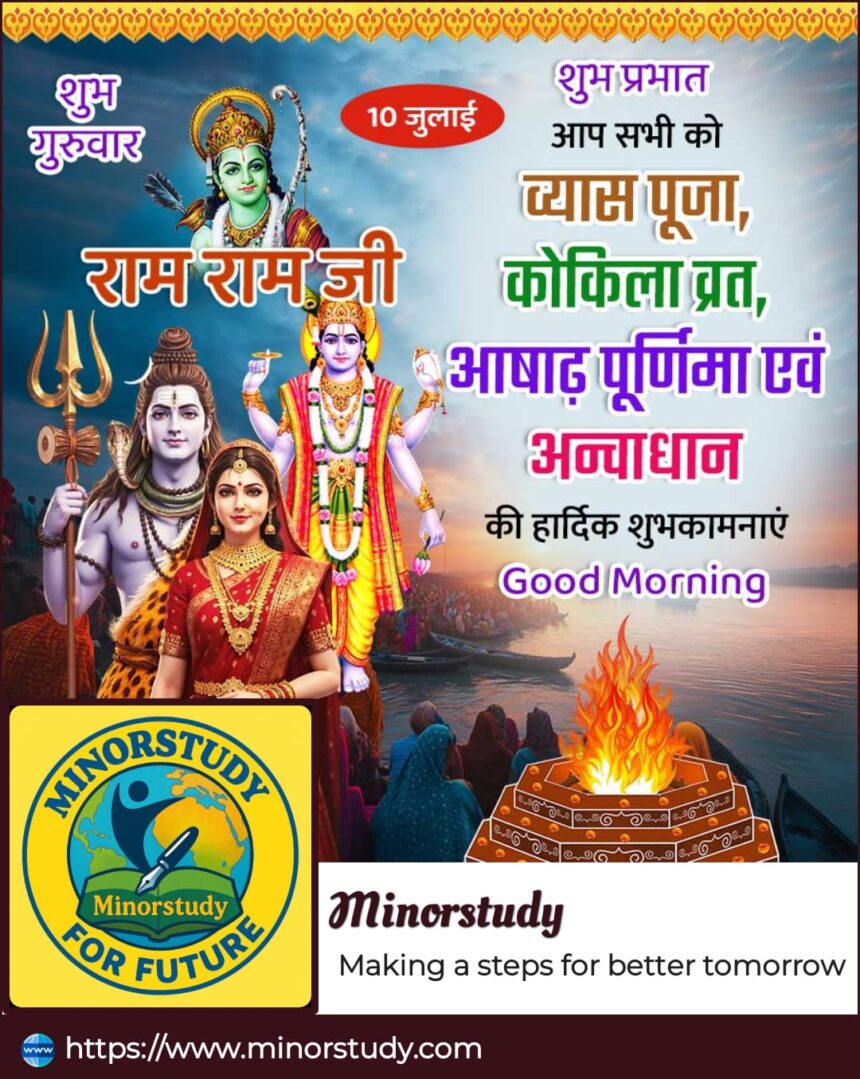8 Enlightening Reasons Why Vyasa Worship on Ashadh Full Moon Brings Transformative Joy
🌕 Introduction
Vyasa Worship: In the heart of Hindu traditions lies a revered celebration deeply rooted in knowledge, devotion, and cultural unity—Vyasa Worship on Ashadh Full Moon, often observed alongside the Nightingale Fast (Kokila Vrat) and Anvadhan ritual. This sacred observance weaves together themes of spiritual awakening, honoring the divine guru, and invoking blessings through discipline and faith.
- 🌕 Introduction
- 📜 History and Mythology
- 🗓️ Timeline of Observance
- 🌟 8 Enlightening Reasons to Observe Vyasa Worship
- 1. 📚 Honoring the Original Teacher of Vedic Wisdom
- 2. 🧘♂️ Cultivating Spiritual Discipline Through Fasting
- 3. 🌱 Nurturing Life-Long Learning and Humility
- 4. 🔗 Reinforcing the Guru–Disciple Bond
- 5. 🤝 Strengthening Cultural Bonds and Unity
- 6. 💡 Illuminating Mental and Emotional Wellbeing
- 7. 🌿 Celebrating at the Peak of Nature’s Fullness
- 8. 🌞 Anvadhan: The Gift of Knowledge
- 🔍 Interesting Facts
- ❓ Frequently Asked Questions (FAQs)
- 🕯️ Wishing Messages for Vyasa Worship Day
- 🔑 Key Takeaways
- 🌍 Impact on Modern Daily Life and Society
- 🔚 Conclusion – Why We Still Need Vyasa Veneration
In this comprehensive guide, written in an approachable, human-friendly tone, we delve into the history, facts, timeline, significance, observance, daily-life impact, wishing messages, and societal importance of this beautiful tradition. Drawing on personal motivations and shared experiences, the story of Vyasa worship is one of learning, transformation, and collective unity.
📜 History and Mythology
Who Is Vyasa?
Vyasa (also known as Ved Vyasa) is regarded as the great sage and compiler of the Vedas, author of the Mahabharata, the Puranas, and a key figure in shaping Hindu spiritual literature. Revered as the Adi Guru (original spiritual teacher), his wisdom laid the foundation for countless generations of seekers.
Origins of the Observance
The tradition of worshipping Vyasa on Ashadh Purnima (full moon) is linked to ancient practices that celebrated the completion of the Vedic compilations and the inauguration of the Guru–shishya (teacher-disciple) lineage. Parallel to rituals of the nightingale-ko câ bani (kokila vrat), this day is often called Vyasa Purnima, though both terms are sometimes used interchangeably at the community level.
In some regions, the Nightingale Fast (Kokila Vrat)—originally linked to Goddess Parvati’s transformation—has naturally blended with reverence for Vyasa, reflecting both spiritual discipline and celebration of wisdom.
🗓️ Timeline of Observance
| Date | Ritual or Event |
|---|---|
| Ashadh Purnima (June–July) | Vyasa Worship début |
| Early Morning | Devotees rise pre-dawn, take a sacred bath |
| After Sunrise | Sacred fire, invocation of Vyasa and guru-mantras |
| Daytime | Fasting (nirjala or restricted), study of scriptures |
| Evening | Recitation of Vyasa-charita (Vyasa’s life), chanting vedic shlokas |
| Anvadhan (Evening) | Symbolic offering of books, knowledge, guru’s blessings |
| Conclusion | Aarti, food offerings, communal feasting, distribution of prasad |
🌟 8 Enlightening Reasons to Observe Vyasa Worship
1. 📚 Honoring the Original Teacher of Vedic Wisdom
Vyasa created the framework of spiritual knowledge spanning time—compiling the mighty Vedas, penning the Mahabharata, and articulating the Bhagavad‑Gita. Worshipping him is an act of paying homage to the source of all spiritual literature.
2. 🧘♂️ Cultivating Spiritual Discipline Through Fasting
The nightingale fast—somewhat akin to kokila vrata—demands:
Fasting (partial or complete)
Scripture reading (Vedas, Gita, Vyasa-charita)
Meditation and reflection on higher truths
These practices help foster mental clarity, inner focus, and humility before knowledge.
3. 🌱 Nurturing Life-Long Learning and Humility
Vyasa’s life teaches us that even the greatest knowledge requires the support of teachers, oral tradition, and humility. Through worship, we honor both wisdom and the process of learning.
4. 🔗 Reinforcing the Guru–Disciple Bond
Offering books, repeating guru‑mantras, chanting the Vyasa Vandana—all act as reminders that without a guru, knowledge falls short. This ritual reaffirms our commitment to seek and receive guidance.
5. 🤝 Strengthening Cultural Bonds and Unity
This observance brings communities together—families, schools, satsangs—through shared prayers, singing, and communal meals. It underscores the continuity of culture and collective values.
6. 💡 Illuminating Mental and Emotional Wellbeing
Ritual immersion in texts offers:
A time-out from routine pressures
A chance to focus on higher values
A mental cleanse, promoting peace, resilience, and joy
7. 🌿 Celebrating at the Peak of Nature’s Fullness
The month of Ashadh represents fertility and growth. Celebrating Vyasa in this spiritually potent time symbolizes an offering of learning and wisdom to the ever-renewing cycle of life.
8. 🌞 Anvadhan: The Gift of Knowledge
In the evening Anvadhan ritual, devotees symbolically present books and knowledge to gurus or institutions, highlighting the community’s willingness to sustain and share wisdom—an offering to the future, not just to a person.
🔍 Interesting Facts
Vyasa is considered one of the seven Chiranjeevis (immortals) with a presence in higher realms.
The term “Vyasa” is a title meaning “divider” or “compiler.”
According to tradition, he also dictated the 18 Puranas and Brahma Sutra.
This observance is less common in mainstream North India but is maintained in Gurukulas, Sanskrit pathshalas, and Vedic schools across India.
❓ Frequently Asked Questions (FAQs)
Q1. Who can observe Vyasa Worship?
Anyone with respect for Vedic or spiritual traditions—students, teachers, families, or devout practitioners—can participate.
Q2. Is fasting necessary?
Not mandatory, but observing a fast (nirjala or sattvik) deepens mindfulness and reverence.
Q3. What is required for Anvadhan?
Essentially a symbolic offering—books, scriptures, or just service to a teacher or library embodying teaching.
Q4. Are children included?
Absolutely! Children are often taught basic prayers in the morning or take part in evening chants—fostering positive spiritual habits.
Q5. Can Vyasa Worship be done in groups?
Yes! Group chanting, community feasts, and satsangs make it a communal, uplifting experience.
🕯️ Wishing Messages for Vyasa Worship Day
🌸 “May the timeless wisdom of Sage Vyasa illuminate your mind and heart. Happy Vyasa Worship Day!”
📚 “On this sacred Ashadh full moon, may your journey in learning be blessed with clarity, humility, and purpose.”
💖 “Wishing you transformative experiences through devotion and knowledge on Vyasa Purnima. May joy and insight fill your life.”
🔑 Key Takeaways
Vyasa Worship on Ashadh Purnima honors the roots of spiritual education.
It merges fasting, scriptural study, and guru offerings into a layered path of devotion.
The tradition promotes mental well-being, cultural unity, and a love for learning.
Celebrating alongside anklayan (group silence/study) and Anvadhan emphasizes service to future generations.
🌍 Impact on Modern Daily Life and Society
Encourages lifelong learning and respect for teachers in educational settings.
Beautifies spiritual living—a periodic retreat into reflection and reverence.
Revitalizes community values, enhancing respect, cooperation, and generosity.
Sustains the Vyasa legacy, bridging modern life with ancient wisdom.
🔚 Conclusion – Why We Still Need Vyasa Veneration
In an age dominated by instant information, we need moments of deep learning, humility, and devotion. Vyasa Worship on Ashadh Full Moon offers not only a link to our cultural heritage but also a path to personal growth and communal harmony.
By combining the beauty of fasting, the depth of Vedic reflection, and the generosity of Anvadhan, this observance invites us to pause, learn, and serve—an integrated approach to living with purpose.
May the day fill your heart with enlightenment, compassion, and the eternal joy of knowledge. Jai Vasudev!








